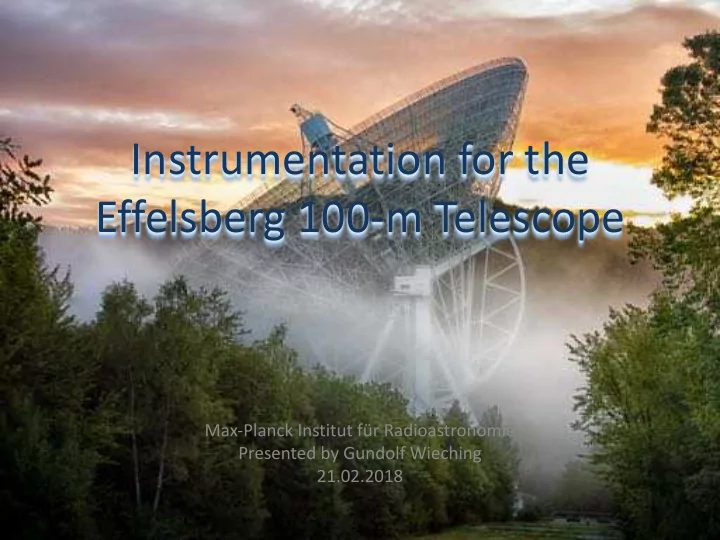

Instrumentation for the Effelsberg 100-m Telescope Max-Planck Institut für Radioastronomie Presented by Gundolf Wieching 21.02.2018
100 m Effelsberg Telescope Inauguration: May 12, 1971 • – Regular operations started on August 1, 1972 • Aperture: 7854 m 2 , Sensitivity > 1.5 K/Jy (≤ 20 GHz) Surface accuracy: ~0.5 mm • Frequency coverage: 300 MHz – 90 GHz • Resolution: • 9’ @ 1.4 GHz – 10” @ 86 GHz, pointing accuracy ~2-3” – Optics: Gregorian • • Homology structure Observing modes: • – continuum, – spectroscopy, – pulsars & transients, – VLBI (European, global, mm) 06.09.2016 TVN 2016
Effelsberg Instrumentation Overview RF start RF stop RF-BW IF-BW No. of Installation Receiver Abbr. GHz GHz GHz GHz Channels beams date 50cm P500 0,3 0,9 0,6 0,6 LCP/RCP 1 2011 PAF 0,7 1,7 0,4 0,3 H/V 37 2017 30cm (UHF) P300 0,8 1,3 0,5 0,1 LCP/RCP 1 1999 L-Band 7 Beam P217 1,3 1,6 0,3 0,3 LCP/RCP 7 2005 18/21cm P200 1,3 1,8 0,5 0,1 LCP/RCP 7 2006 UBB P170 0,6 3 2,4 2,4 H/V 1 2012 13cm S130 2,2 2,3 0,1 0,1 LCP 1 2004 11cm S110 2,6 2,7 0,1 0,1 LCP/RCP 1 2002 9cm P90 2,9 3,6 0,7 0,1 LCP 1 1985 6cm S60 4,6 5,1 0,5 0,5 LCP/RCP 2 1995 5cm P50 5,8 6,8 1 0,5 LCP/RCP 1 2003 C + -Band S45 4 9,3 7,3 4 H/V 1 (2*) 2014 3.6cm S36 8 9,2 1,2 0,5 LCP/RCP 1 2004 2.8cm S28 10,3 10,6 0,3 0,1 LCP/RCP 2 1980 2.2cm P22 12,1 13,6 1,5 0,1 LCP/RCP 1 1990 Ku-Band* 12 18 6 6 LCP/RCP 2 2017* 2cm S20 14 16 2 0,5 LCP/RCP 1 1998 1.9cm P19 13,5 18,7 5,2 0,5 H 1 2000 K-Band S14 18 26,5 8,5 8,5 H/V 2 2013 1cm P10 27 38,7 11,7 2 H 1 1996 9mm S9 30 34 4 0 LCP/RCP/H/V 7 2008 Q-Band* 33 50 17 4 LCP/RCP 2017* 7mm S7 41,6 44,4 2,8 0,5 RCP 1 1998 3mm P3 84 96 12 2 LCP/RCP 1 1999
Frequency coverage 3mm 7mm Q-Band* 9mm 1cm K-Band 1.9cm 2cm Ku-Band* 2.2cm 2.8cm 3.6cm C+-Band 5cm 6cm 9cm 11cm 13cm UBB 18/21cm L-Band 7 Beam 30cm (UHF) PAF* 50cm 0,1 1 10 100 RF Frequency in GHz
Effelsberg Focus System Primary Focus Secondary Focus
Ultra-Broad-Band Receiver Designed for Pulsar observations • increase in bandwidth -> sensitivity • Feed covers 0.6GHz – 3.0GHz RFI requires filtering • T rec < 20K • Baseband detection (1.3 – 2.6GHz) • PSR$B1933+16$ 1600 1400 L-BAND L-BAND 1200 frequency (MHz) 1000 800 600 0.4 0.6 0.8 1 1.2 1.4 1.6 1.8 2 credit to Paulo Freire time (sec)
K-Band 18 – 26 GHz Receiver Two feeds • IF Modes: • – Mode I: LCP, RCP at two feeds 8 x 2.5GHz res: 45KHz – Mode II: LCP at one feed 28 x 300 MHz, res: 5.4 kHz – 4 GHz VLBI IF K-Band IF modules K-Band synthesizer
K-Band 18 – 26 GHz Receiver Sensitivity: T rec < 20K T Sys < 55K (weather dominated)
C + -Band Receiver Design Specifications RF frequency range 4.0 - 8.0 GHz 5.3 - 9.3 GHz number of feeds 1 (final implementation: 2) polarization linear polarisation, cross-polar. < -20 dB system sensitivity T rec : <20 K full band IF spectroscopic 4 x 2.5 GHz, res: 44.3 kHz (1.6 km/s @ 8 GHz) zoom IF spectroscopic 4 x 300 GHz, res: 5.3 kHz (0.29 km/s @ 8 GHz) IF generic/VLBI 2 x 0 – 4.0 GHz calibration source noise source, line source
Q-Band Receiver Design Specifications , instantaneous bandwidth 4x 4GHz ( 4 channels ) RF frequency range 38 - 50 GHz spectrometers possible feeds Dual cryogenic horn Polarization Circual polarisation cross-polar. < -20 dB System sensitivity T rec : < 45 K Full band IF spectroscopic 8 x 2.5 GHz, res: 44.3 kHz IF generic/VLBI 4 x 4.0 GH Calibration source noise source, line source
Ku- Band Receiver Design Specifications RF frequency range 12.0 - 18.0 GHz number of feeds 2 corrugates horns polarization 2 x circular polarized (cross-pol. <-20dB) system sensitivity T rec : 20K full band IF spectroscopic 12 x 2.5GHz, res: 44.3kHz IF generic/VLBI 2 x 4.0GHz calibration source noise source, line source
Phased Array Feed (PAF) for Effelsberg Modified ASKAP PAF • Band ASKAP (MHz) MPIfR (MHz 188 dipole antennas • 1 700-1200 700-1200 (94 per polarization) 2 840-1440 1200-1480 Frequency range 0.7GHz – 1.8GHz • 300 MHz instantaneous bandwidth • 3 1400-1800 1340-1740 36x2 independent beams • 4 600-700 600-700 Science commissioning Dec 2017 • Xinping Deng et. al. IAU 2017
Recommend
More recommend